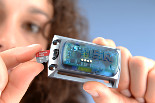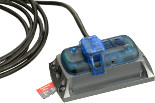Pilot study on using SRT Zeptor®medical for the postoperative rehabilitation of patients with knee prostheses
MSR165 Data Logger measures the level of stress (g-forces) on the patient
Author: Monika Niggli, Fachhochschule Südschweiz Physiotherapie Graubünden, Landquart
Vibration stimuli have been researched in depth for a number of years. After discovering that these stimuli also have positive effects on the neuromuscular and neuroendocrine system, research projects in the field of fitness and prevention are common and are increasingly also used in the medical and therapeutic environment.
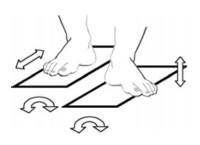 In contrast to the sinusoidal two-dimensional vibration devices, the SRT A devices have been in use for some time. They transfer three-dimensional oscillations in terms of stochastic resonance vibrations (random frequency vibrations and harmonies) via two separate, independent foot plates onto the human body (Figure 1). These devices operate in the low frequency range (1-12 Hz).
In contrast to the sinusoidal two-dimensional vibration devices, the SRT A devices have been in use for some time. They transfer three-dimensional oscillations in terms of stochastic resonance vibrations (random frequency vibrations and harmonies) via two separate, independent foot plates onto the human body (Figure 1). These devices operate in the low frequency range (1-12 Hz).
Within the context of a pilot study, which was carried out to obtain a Masters Degree in Physical Therapy Sciences at the University of Applies Sciences and Arts of Southern Switzerland (Fachhochschule SUPSI Landquart), the therapeutic effects of whole body vibrations on patients following surgical treatment of osteoarthritis of the knee (with total prosthesis or unicondylar knee prosthesis) were to be investigated. The aim of the pilot study was to ascertain whether the application of the SRT Zeptor®medical in the functional postoperative care improves the ability to walk and gait performance compared to isolated functional postoperative care.
This could present an opportunity to increase the efficiency of the postoperative care and to discharge the patients from the postoperative rehabilitation in a better general condition. Therefore, due to their greater efficiency with regard to stimulation of nerve cells and muscles, therapy programmes in conjunction with the Zeptoring® could be used as a positive aid for postoperative rehabilitation.
The nine test subjects were randomly divided into two groups (ZEPTOR PLUS and KON). Both completed a prescribed programme consisting of conventional physiotherapy and a home programme. Twice a week over a period of six weeks, the ZEPTOR PLUS group completed their motor co-ordination programme on the SRT Zeptor®medical instead of a hard floor like the KON group did. All other therapeutic interventions were scheduled the same. At the time of the study no other studies concerning postoperative care for prostheses of the knee with stochastic resonance therapy and the SRT Zeptor®medical had been published.
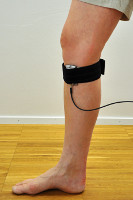 When training using vibration stimuli, foot plates are used to transfer mechanical oscillating vibrations first to the feet and then towards the cranium. This means that periodic changes of force, acceleration and deflection impact upon the body. The human body is a system whose components resonate upon specific stimulation at a suitable frequency (natural frequency). Excessive or inadequate stress in terms of acceleration (rigid components) or frequencies (soft tissue) can result in damage to structures and organs. Therefore, when using whole body vibration training, the frequency, direction and duration of exposure, as well as the average acceleration must be taken into consideration. In addition, the entire body’s current ability to withstand stress should be included when planning the dosage. For this reason, the primary focus was to investigate the stress through the stochastic vibrations with respect to their damaging effect on the knee prostheses. In order to confirm the information provided by the manufacturer of the SRT Zeptor® medical with respect to the intensity of the medical programmes, the accelerations in all three axes were measured using an MSR165 data logger and subsequently compared with the functional stress when walking.
When training using vibration stimuli, foot plates are used to transfer mechanical oscillating vibrations first to the feet and then towards the cranium. This means that periodic changes of force, acceleration and deflection impact upon the body. The human body is a system whose components resonate upon specific stimulation at a suitable frequency (natural frequency). Excessive or inadequate stress in terms of acceleration (rigid components) or frequencies (soft tissue) can result in damage to structures and organs. Therefore, when using whole body vibration training, the frequency, direction and duration of exposure, as well as the average acceleration must be taken into consideration. In addition, the entire body’s current ability to withstand stress should be included when planning the dosage. For this reason, the primary focus was to investigate the stress through the stochastic vibrations with respect to their damaging effect on the knee prostheses. In order to confirm the information provided by the manufacturer of the SRT Zeptor® medical with respect to the intensity of the medical programmes, the accelerations in all three axes were measured using an MSR165 data logger and subsequently compared with the functional stress when walking.
The data logger was attached to the front of the tibia in the middle, using a non-elastic fixing strip with hook-and-loop fastener for taking the measurements. Then measurements were taken on the same person for “high”, “moderate”, “medium” and “low” intensities scheduled for the study (Figure 2). Between measurements, the test subjects had a break so as to prevent excessive fatigue.
Measurement results and reference values
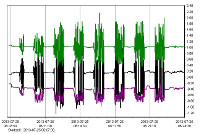 The maximum values of the axial stress during the knee prostheses programme were in the range of around +2.1 g. Less the standard load of 1 g, this means an additional load of approximately +1.1 g (Figure 3).
The maximum values of the axial stress during the knee prostheses programme were in the range of around +2.1 g. Less the standard load of 1 g, this means an additional load of approximately +1.1 g (Figure 3).
As a check value, measurements were taken when walking the distance of the Six-Minute Walk Test as the patients were all allowed and able to walk without a stick at the time of the ZEPTOR intervention. At a brisk speed, the values of the additional load were around +1.4 g to +2.4 g. The maximum values were significantly higher than at the highest setting of the Zeptor, primarily when starting, turning at the turning points and stopping. (Figure 4)
Result regarding the possible application of the SRT Zeptor®medical vibration plate
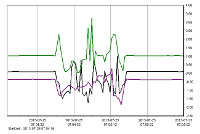 The measurements taken by means of the MSR165 data logger within the context of the pilot study therefore show that even patients who have undergone knee prosthesis surgery can be treated with the SRT Zeptor®medical vibration plate. The maximum accelerations of the Zeptoring® were in the maximum range of 1.1 g; when walking and turning, they were three times that.
The measurements taken by means of the MSR165 data logger within the context of the pilot study therefore show that even patients who have undergone knee prosthesis surgery can be treated with the SRT Zeptor®medical vibration plate. The maximum accelerations of the Zeptoring® were in the maximum range of 1.1 g; when walking and turning, they were three times that.
None of the group’s test subjects had to terminate the treatment using the Zeptoring® or made negative comments. At no time did the test subjects feel overstrained due to the continuous, slow increase of the intensity. Of the five programmes tested and recommended by the manufacturer for knee prostheses, the programmes “low”, “medium” and “moderate” were used and proved to work well.
However, it should be noted that the load maximums occur particularly in the medium phases and are dependent on the position. Increased stress on the heels triggers peaks!
List of references
- Abercromby AFJ, et al. variation in neuromuscular responses during acute whole body vibration exercise. Med Sci Sports Exerc. 2007 Sep;39(9):1642-50.
- Furness TP, Maschette WE,. Influence of whole body vibration platform frequency on neuromuscular performance of community dwelling older adults. Journal of strength and conditioning research; 23(5); 1508-1513.
- Cardinale M, Bosco C,. The use of vibration as an exercise intervention-review. Exerc Sport Sci Rev. 2003 Jan;31(1):3-7.
- Rittweger J. Vibration as an exercise modality: how it may work, and what its potential might be. Eur J Appl Physiol. 2010 Mar;108(5):877-904.
- Cardinale M, et al. The use of vibration as an exercise intervention. Exerc Sport Sci Rev. 2003 Jan;31(1):3-7.
- Haas CT, et al. Biomechanische und physiologische Effekte mechanischer Schwingungsreize beim Menschen. Deutsche Zeitschrift für Sportmedizin 2004: Jahrgang 55, Nr. 2.
- Abercromby AFJ, et al. Vibration exposure ans biodynamic responses during whole-body vibration training. Med Sci Sports Exerc. 2007 Oct;39(10):1794-800.
- Kiiski J, et al. Transmission of Vertical Whole Body Vibration to the Human Body. J Bone Miner Res. 2008 Aug;23(8):1318-25.
- Rogan S, et al. Stochastic resonance whole-body vibration training for chair rising performance on untrained elderly. Arch Gerontol Geriatr. 2012 Sep-Oct;55(2):468-73.
Can we also help you with your measuring tasks? We would be pleased to advise you!
You may also be interested in these articles:
- MSR165: Rugged 3-axis shock logger for long-term measurements
- Fall detection by smart phone in older adults - with Data Logger MSR145
- Healthcare management MSR145 Data Loggers for internet-based health projects
- MSR data logger used for space medicine: Cell culture experiments in microgravity
- MSR Technology integrated in Pelvic Floor Trainer
- MSR145 Data Loggers: Evaluation of a fast single sample pneumatic tube system
- The fast way to the right datalogger
 Deutsch
Deutsch

